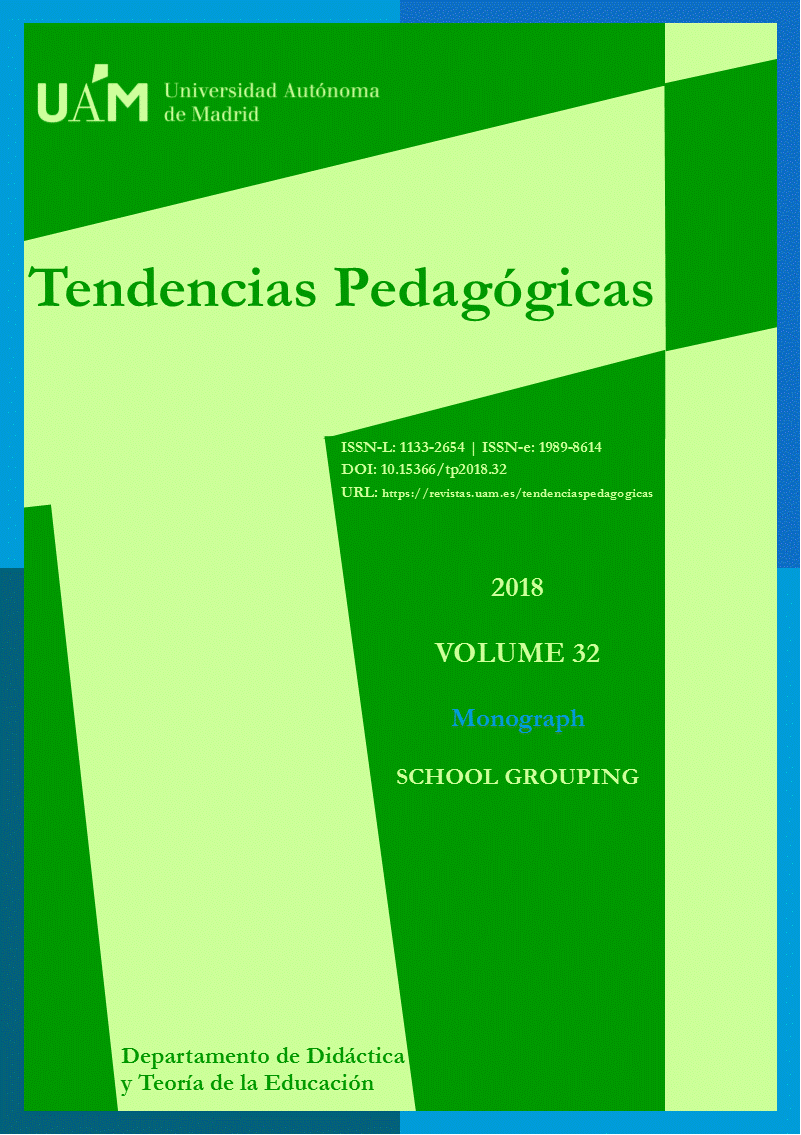Keywords:
grouping practices, teachers’ beliefs and expectations, compulsory secondary education, school segregation, educational disadvantageAbstract
Grouping students by ability inside schools is a strategy that is spread in many educational systems, although they are under the principles of comprehensiveness. This is the case of Catalonia where, according to PISA 2015, 26% of students are enrolled in secondary schools that group their students by ability in all subjects (6% on average in Spain). This article aims to explore the grouping practices from the data obtained in an ethnography carried out at a secondary school in Catalonia located in a highly disadvantaged context. The research offers conclusive results regarding the ways in which grouping practices, subject to teachers’ beliefs and expectations, condition young people’s experiences, and contribute to naturalize situations of educational and social disadvantage of the most disadvantaged students.
Downloads
References
Abadzi, H. (1985). Ability Grouping Effects on Academic Achievement and Self-Esteem Who Performs in the Long Run as Expected. Journal of Educational Research, 79(1), 36-40. doi: 10.1080/00220671.1985.10885644.
Anyon, J. (1981). Social Class and School Knowledge. Curriculum Inquiry, 11(1), 3-42. doi: 10.1080/03626784.1981.11075236.
Becker, H. S. (1952). Social-Class Variations in the Teacher-Pupil Relationship. Journal of Educational Sociology, 25(8), 451-465. doi: 10.2307/2263957.
Booth, T., & Ainscow, M. (2002). Index for Inclusion: developing learning and participation in schools. Centre for Studies on Inclusive Education (CSIE).
Carrasco, S., Pàmies, J., Ponferrada, M., Ballestín, B., & Bertran, M. (2011). Segregación escolar e inmigración en Cataluña: aproximaciones etnográficas. En Garcia Castaño, F. J., & Carrasco, S. (Eds.), Investigaciones en Inmigración y Educación en España. Homenaje a Eduardo Terrén Lalana (pp. 369-403). Madrid: CIDE-Ministerio de Educación.
Castejón, A. (2017). Expectativas docentes, agrupamiento del alumnado y segregación escolar. Una etnografía en entornos de alta complejidad social en Cataluña. Tesis Doctoral. Departamento de Pedagogía Sistemática y Social, Universitat Autònoma de Barcelona.
Díaz de Rada, Á. (2006). Etnografía y técnicas de investigación antropológica. Madrid: UNED.
Dupriez, V. (2010). Methods of Grouping Learners at School. Paris: UNESCO.
Dupriez, V., & Dumay, X. (2006). Inequalities in school systems: effect of school structure or of society structure? Comparative Education, 42(2), 243-260. doi: 10.1080/03050060600628074.
Flick, U. (2004). Introducción a la investigación cualitativa. Madrid: Morata.
Gamoran, A. (1992). Synthesis of Research: Is Ability Grouping Equitable? Educational Leadership, 50(2), 11-17.
Gamoran, A. (2009). Tracking and Inequality: New Directions for Research and Practice (No. 2009-6, WCER Working Paper). Madison: University of Wisconsin-Madison, Wisconsin Center for Education Research.
Geertz, C. (1990). La interpretación de las culturas. Barcelona: Gedisa.
González-Motos, S. (2012). Experiencias escolares iniciales del alumnado inmigrantes: experiencias que marcan. Educación XX1, 15(2), 137-158.
Horn, D. (2009). Age of selection counts: a cross-country analysis of educational institutions. Educational Research and Evaluation, 15(4), 343-366. doi: 10.1080/13803610903087011.
Husén, T. (1973). Implications of IEA Findings for the Philosophy of Comprehensive Education. Harvard University, Cambridge: Paper presented at the Conference on Educational Achievement.
Kelly, S., & Carbonaro, W. (2012). Curriculum tracking and teacher expectations: evidence from discrepant course taking models. Social Psychology of Education, 15(3), 271-294.
Kutnick, P., Sebba, J., Blatchford, P., Galton, M., & Thorp, J. (2005). The Effects of Pupil Grouping: Literature Review. University of Brighton, Research Report 688.
Lahire, B. (2008). Un sociólogo en el aula: objetos en juego y modalidades. En Rociles Rubio, M.A., & Franzé Mudanó, A. (Coords.), ¿Es la escuela el problema? Perspectivas socio-antropológicas de etnografía y educación (pp. 49-60). Madrid: Trotta.
Oakes, J. (1982). The reproduction of inequity: The content of secondary school tracking. The Urban Review, 14(2), 107-120. doi: 10.1007/BF02174647.
Pàmies, J. (2013). El impacto de los agrupamientos escolares. Los espacios de aprendizaje y sociabilidad de los jóvenes de origen marroquí en Barcelona. Revista de Educación, 362 (Septiembre-diciembre 2013), 133-158.
Pàmies, J., Carrasco, S., & Casalta, V. (2014). Más allá del extrañamiento. Negociaciones y rupturas, o cuando el maestro deviene etnógrafo. En Osuna C., & Mata-Benito, P. (Eds.), Gestión de acceso al campo y devolución de los resultados: Contextos múltiples de socialización y aprendizaje. Un análisis desde la etnografía de la educación (pp. 19-24). Traficantes de Sueños.
PISA (2015). PISA 2015 Database. Recuperado de: http://www.oecd.org/pisa/.
Ponferrada, M. (2009). Efectos escolares y sociales de la separación por niveles en un instituto de secundaria de la periferia de Barcelona. Papeles de Economía Española, 119, 69-83.
Rubio, M. (2013). Construyendo diferencias desde las retóricas de la igualdad: el caso del alumnado denominado latinoamericano en la etapa de Educación Secundaria Obligatoria. Granada: Universidad de Granada.
Serra, C. (2001). Identitat, racisme i violència. Les relacions interètniques en un institut català. Girona: Universitat de Girona.
Slavin, R.E. (1988). Synthesis of research on grouping in elementary and secondary schools. Educational leadership, 46(1), 67-77.
Sukhnandan, L., & Lee, B. (1998). Streaming, setting and grouping by ability: a review of the literature. National Foundation for Educational Research.
Wolcott, H.F. (1993). Sobre la intención etnográfica. En Velasco Maillo, H. M., García Castaño, F. J., & Díaz de Rada Brun, Á. (Coords.), Lecturas de Antropología para Educadores (pp. 127-145). Madrid: Trotta.
